Digital Branding Strategies
10 Essential Website Design Tips for a Stunning Online Presence
Overview
The article centers on delivering essential website design tips that are pivotal in crafting a stunning online presence. It asserts that effective website design necessitates a strategic approach, encompassing:
- Clear objectives
- Prioritization of user experience
- Responsive design
- High-quality visuals
- Consistent branding
These elements are crucial for engaging visitors and achieving business goals. By focusing on these key aspects, Brand Managers can elevate their online platforms and drive meaningful interactions.
Introduction
In the digital age, a well-designed website is not merely a luxury; it is an essential requirement for businesses intent on thriving online. As competition intensifies, grasping the key elements of effective web design becomes crucial. This article explores the fundamental strategies for crafting an impactful website, ranging from:
- The development of a comprehensive design plan
- The prioritization of user experience
- The maintenance of consistent branding
Readers will uncover how to leverage:
- Visual hierarchy
- High-quality visuals
- Compelling calls to action
to enhance engagement and drive conversions. With insights drawn from industry experts and successful case studies, this guide empowers businesses with the knowledge necessary to elevate their online presence and achieve enduring success.
Develop a Comprehensive Website Design Plan
Establishing your site’s goals is paramount among the key website design tips for efficient creation. Begin by identifying your target audience and the essential functionalities your site must offer. This foundational step ensures that your online presence aligns with your business objectives and addresses audience needs—a principle that WonderEight emphasizes in its comprehensive website design tips and digital marketing solutions.
Next, develop a detailed sitemap that outlines the structure of your site, highlighting main pages and subpages. This roadmap is crucial for guiding your creation process, ensuring that every element serves a specific purpose. A well-structured sitemap not only enhances user navigation but also bolsters SEO efforts, as search engines favor organized content—a strategy that WonderEight employs to optimize client platforms.
To visualize the arrangement and flow of your online platform before engaging in the actual creation, consider utilizing wireframes. These tools allow you to experiment with various layouts and functionalities, ensuring that the final outcome is both user-friendly and visually appealing, reflecting the innovative approach that WonderEight takes in its projects.
Statistics indicate that eCommerce platforms account for approximately 14% of all sites on the internet, underscoring the competitive landscape in which your platform will operate. Thus, applying website design tips as best practices in online platform planning is crucial, and WonderEight’s expertise can assist you throughout this process.
Expert opinions highlight the importance of setting clear website objectives, which are among the essential website design tips that influence every facet of the creation process. As Alec Hanak, Head of Design at WonderEight, states, “Driven by strategy and logic, I take pride in crafting unparalleled pixel-perfect visuals.” This approach not only enhances visual appeal but also ensures that the structure is strategically sound.
Furthermore, analyzing successful case studies, such as the extensive campaigns for Mirinda and Quaker Oats created by WonderEight, illustrates how strategic planning in website creation can connect with audiences and enhance engagement. WonderEight distinguishes itself by blending creativity with technology, providing tailored solutions that improve both user experience and business results.
Incorporating transparency and measurable results into your creation process is also vital, as emphasized by industry leaders. By integrating these components into your digital layout strategy, you will significantly enhance your chances of establishing a remarkable online presence that resonates with your audience and drives business outcomes—a goal that WonderEight is dedicated to achieving for its clients.
Prioritize User Experience (UX) in Your Design
To effectively prioritize user experience (UX) in website design, it is essential to conduct thorough research that uncovers the needs and preferences of your target audience. This foundational step facilitates the implementation of intuitive navigation, allowing individuals to effortlessly locate the information they seek. Clear labeling of menus and buttons, combined with a logical flow throughout the site, enhances usability and keeps visitors engaged.
Regularly collecting feedback from clients is indispensable for identifying pain points and areas that require improvement. This iterative process not only enhances the experience but also fosters a sense of connection with your audience. Notably, organizations that adopt mature research practices are 1.9 times more likely to report enhanced customer satisfaction, underscoring the importance of understanding client needs.
In 2025, UX design trends highlight the significance of mobile optimization. Statistics reveal that:
- 66% of mobile sites have tappable elements placed too closely together
- 32% feature elements that are too small
Addressing these issues can significantly enhance interaction and satisfaction. Moreover, companies such as Staples have witnessed extraordinary outcomes, reporting a 500% rise in online revenue following a UX-centered site redesign, emphasizing the tangible benefits of prioritizing experience.
Successful implementations of UX design are evident in the comprehensive campaigns developed by WonderEight for brands like Miranda and Quaker Oats. These campaigns not only emphasized engaging content but also prioritized experience, showcasing the agency’s expertise in crafting effective branding strategies that resonate with target audiences. By enhancing client experience, these campaigns improved engagement and customer loyalty.
Incorporating research from individuals in your site creation process is not merely advantageous; it is crucial. As Ashley Bhalerao, a Content Marketer at VWO, articulates, ‘Content, memes, and movies – these three words perfectly describe my life (in a nutshell).’ By understanding user behavior and preferences, you can apply website design tips to create an online platform that not only looks stunning but also functions seamlessly, ultimately driving better engagement and conversion rates.
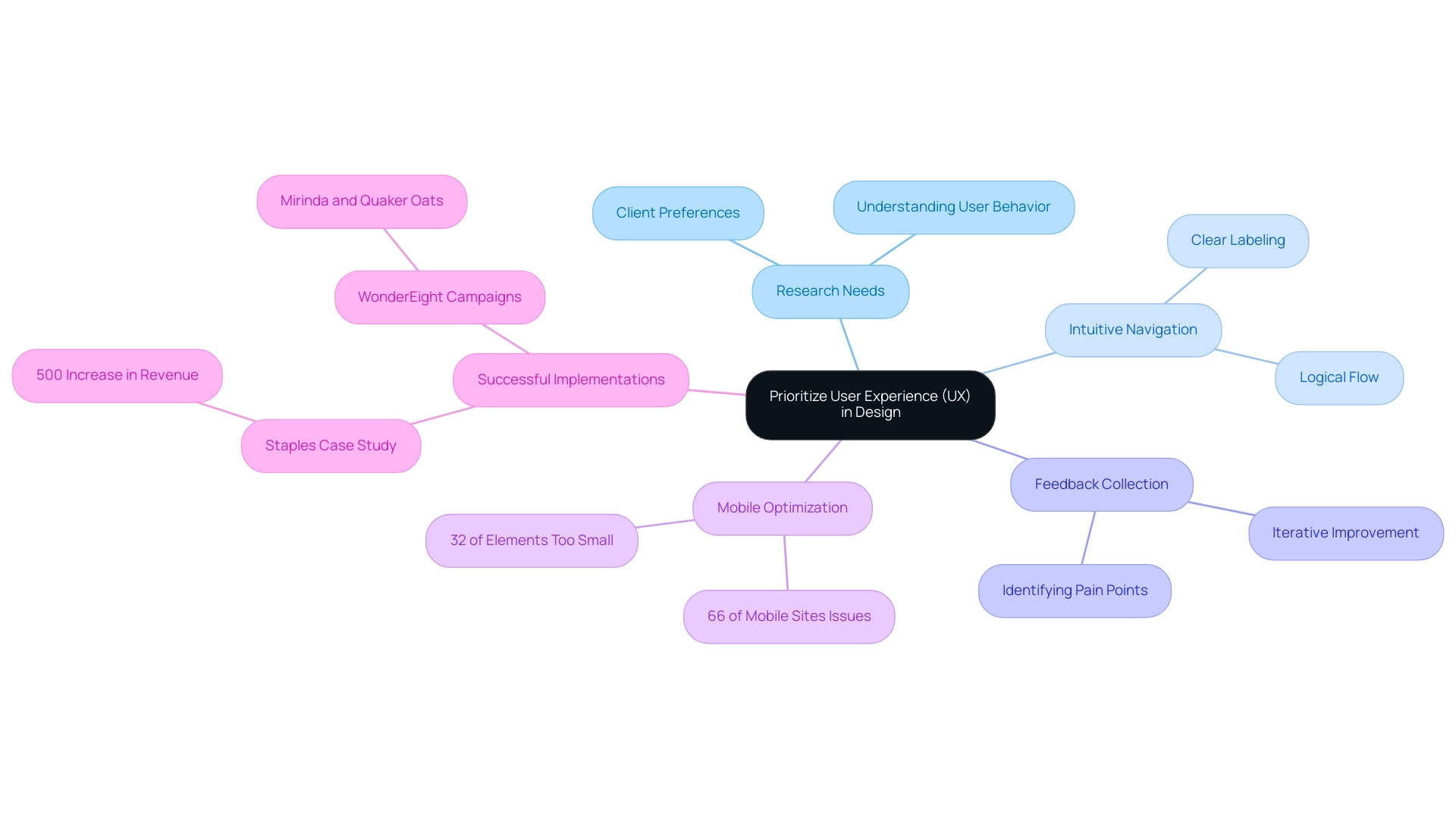
Implement Responsive Design for All Devices
Utilizing flexible grid layouts and media queries is crucial for creating a responsive design that adapts effectively to various screen sizes. This approach offers essential website design tips, ensuring that your platform maintains its visual integrity and functionality across devices—from smartphones to desktops. Testing your website on various devices is vital, as it guarantees that all elements display correctly and that navigation remains intuitive for visitors.
Mobile optimization must be a top priority. In the United States, mobile web traffic peaked at 50.42% in 2022, underscoring the importance of adhering to website design tips, with projections indicating a rise to 46.11% by the end of 2024. Furthermore, mobile phone sales are expected to double by 2025, reaching an impressive $710 billion. This trend highlights the necessity for businesses to invest in mobile-friendly website design tips, as a significant portion of web traffic now originates from mobile devices.
Recent statistics reveal that 63% of mobile users are more likely to purchase from companies offering personalized product recommendations, emphasizing the importance of tailoring experiences to meet customer expectations.
To evaluate your site’s responsiveness, tools like Google’s Mobile-Friendly Test provide valuable insights. Additionally, employing responsive web design techniques, such as fluid grids and flexible images, enhances the experience and engagement of visitors. Notable examples of successful mobile optimization can be found in branding agency websites that prioritize user-friendly interfaces and seamless navigation.
As Khyati Hooda, an SEO specialist, observes, “As technology advances and user behavior evolves, one thing is clear—mobile is shaping the future of how we connect, consume, and communicate online.” As we approach 2025, the significance of responsive design will only amplify. Experts assert that a well-optimized mobile experience, as highlighted in website design tips, is not merely a luxury but a necessity for brands aiming to connect effectively with their audience.
By adopting these strategies, you can ensure that your online presence not only meets current standards but also distinguishes itself in an increasingly competitive digital landscape.
Leverage Visual Hierarchy to Guide User Navigation
Establishing a clear visual hierarchy is crucial for effective website design. It differentiates various elements on your page through size, color, and contrast. By making important information more prominent, you draw attention to key messages, while secondary content can be presented in a less visually striking manner. Employing headings and subheadings not only divides text but also directs individuals through your content effortlessly.
Consistent positioning of navigation elements significantly improves user experience, enabling visitors to swiftly find the information they desire. A well-organized visual hierarchy greatly influences navigation; research indicates that 78% of mobile-based searches for local businesses result in offline purchases. This underscores the significance of an intuitive layout that promotes engagement. Moreover, in 2022, mobile web browsing exceeded desktop browsing by 15%, emphasizing the need for mobile-friendly design.
Successful examples of visual hierarchy steering navigation can be observed in various case studies. For instance, WonderEight’s comprehensive campaign for Quaker Oats effectively conveyed the brand’s values through strategic visual elements, resulting in improved sales and a positive brand image among health-conscious consumers. This illustrates how careful planning can yield quantifiable results, particularly when it aligns with audience expectations and preferences.
Expert insights recommend utilizing size, color, and contrast effectively to create a visually attractive and functional website. As noted by design professionals, these elements play a pivotal role in capturing user attention and enhancing overall navigation. Ashley Bhalerao emphasizes that a study revealed the top 10 companies leading in customer experience outperformed the S&P index with more than 3x returns. This reinforces the idea that prioritizing visual hierarchy can lead to significant business success.
By prioritizing visual hierarchy, companies can create a stunning online presence that resonates with their audience and drives engagement.
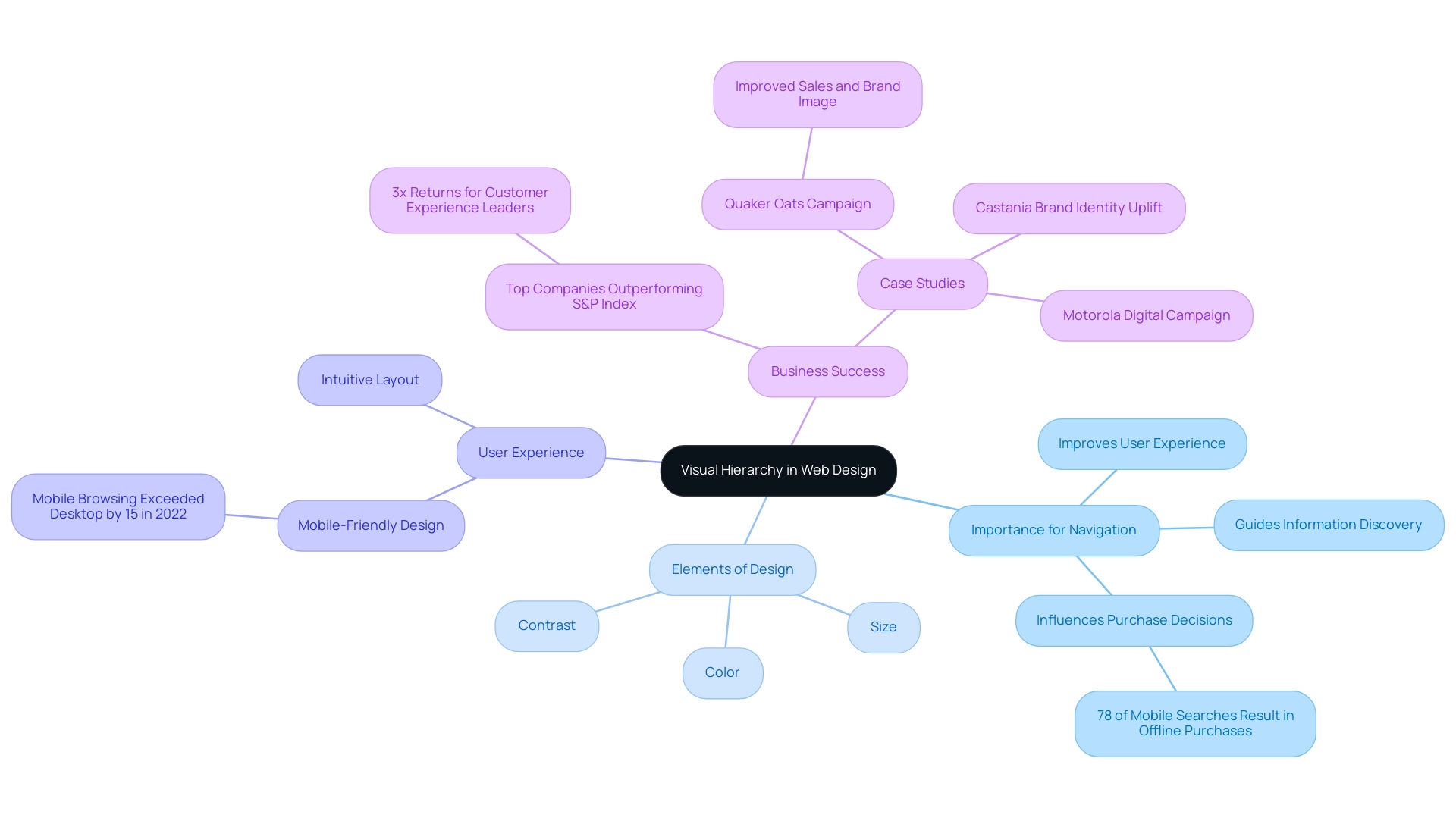
Use High-Quality Visuals to Enhance Aesthetics
Incorporating high-resolution images, videos, and graphics that align with your identity is essential for establishing a compelling online presence. Instead of relying on generic stock photos, prioritize original visuals that authentically represent your brand. This strategy not only enhances brand recognition but also cultivates a deeper connection with your audience, a fundamental principle of WonderEight’s innovative branding strategies.
To ensure optimal performance, all visuals must be meticulously optimized for web use, which is critical for maintaining fast loading times—a vital factor in user experience and SEO. Infographics, in particular, excel at conveying complex information in a visually engaging and easily digestible format, catering to the preferences of today’s consumers who increasingly favor visual content.
Statistics reveal that individuals following directions with text and illustrations perform 323% better than those without illustrations, underscoring the necessity of integrating visuals into your design strategy. Furthermore, as video content continues to dominate, with platforms such as YouTube boasting over two billion registered monthly users, companies must seize this opportunity to enhance engagement and reach. As Celeste Yates, a content writer, observes, “89% of consumers expect brands to increase their video content in 2025.”
Expert insights emphasize that high-quality visuals are not merely an aesthetic choice but a strategic necessity. The case study on visual content marketing statistics for 2024 indicates that video is the most popular media format among marketers, highlighting the escalating importance of visual content across major social networks. Investing in original and high-quality visuals can significantly influence design, leading to improved user engagement and conversion rates.
Successful branding agency platforms, including those developed by WonderEight, exemplify this trend by showcasing original visuals that effectively communicate their unique value propositions. By adhering to these website design tips, companies can elevate their online presence and leave a lasting impression on their audience.
Craft Clear and Concise Website Copy
Crafting website copy that is straightforward and to the point is essential for effective communication. Avoiding jargon and overly complex language not only enhances clarity but ensures that your message resonates with your audience. Utilizing short paragraphs and bullet points significantly improves readability, making it easier for visitors to digest information quickly.
Focusing on the benefits of your products or services is crucial. This approach emphasizes what distinguishes your offerings and aligns your messaging with your identity, creating a cohesive experience for users. Consistently reviewing and updating your copy is essential to maintain its relevance and engagement, reflecting any changes in your identity or market trends.
Successful examples of clear and concise online copy can be seen in campaigns executed by WonderEight, such as the revitalization of Quaker Oats’ brand image, which significantly increased consumer engagement. This case study illustrates how effective messaging can lead to measurable outcomes, reinforcing the importance of clarity in communication.
Data indicate that succinct text can significantly influence audience interaction; platforms with clear messaging experience higher retention rates and lower bounce rates. Expert insights suggest that using large fonts (18px or higher) and maintaining an adequate line-height of at least 1.5 times the font size can further enhance readability. Additionally, organizing content with headers and bullet points aids in scannability and maintains the interest of visitors.
As Howard Gossage famously stated, “At 60 miles an hour the loudest noise in this new Land-Rover comes from the roar of the engine,” emphasizing the need for clarity in communication. Incorporating these strategies into your design will enhance user experience and drive better engagement, ultimately leading to increased conversions. Furthermore, client success stories from WonderEight, such as the brand identity uplift for Castania and the digital campaign for Motorola, showcase the effectiveness of clear messaging in achieving impactful results.
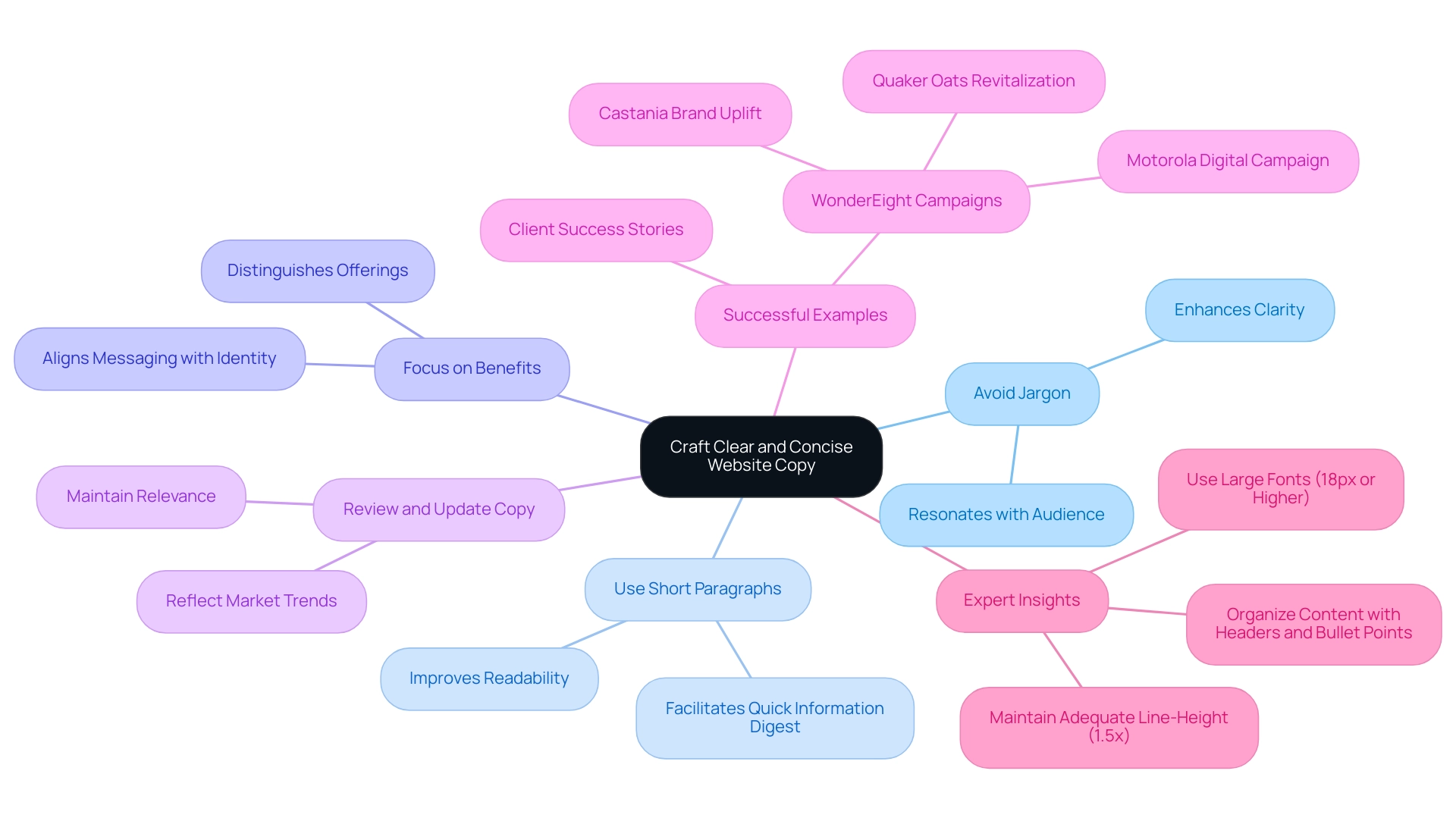
Integrate Effective Calls to Action (CTAs)
To create effective calls to action (CTAs) on your website, it is essential to prioritize visual distinction and clarity in communication. Incorporate action-oriented phrases such as ‘Sign Up Now’ or ‘Get Started Today’ to encourage engagement. The strategic placement of CTAs is crucial; they must be easily accessible throughout your site without overwhelming the user experience.
A/B testing stands as an essential practice for optimizing CTAs. By experimenting with different designs and placements, you can identify which variations resonate most with your audience. This process is vital for refining CTAs, as it allows you to determine the most effective elements for specific audiences.
For instance, studies indicate that pop-ups can achieve conversion rates between 1% and 8% for email capture forms, while strategically placed welcome gates can yield even higher conversion rates of 10% to 25%. This data underscores the importance of thoughtful placement in maximizing audience engagement.
Incorporating expert opinions can further enhance your approach. Marketing professionals emphasize the significance of strategic CTA placement, observing that the wording can greatly influence perception and action. For example, Joe Kevens, director of demand gen at PartnerStack, suggests that a CTA like ‘Get Started’ may feel more inviting and helpful compared to a more sales-oriented phrase like ‘Book a Demo.’ This insight highlights the need for careful consideration of language in your CTAs.
Additionally, statistics reveal that optimizing CTAs can lead to conversion rate improvements ranging from 111% to 306%. This data emphasizes the significance of careful planning and positioning in influencing participant actions. By concentrating on these effective website design tips for creating call-to-action strategies, you can significantly enhance your site’s performance and user engagement.
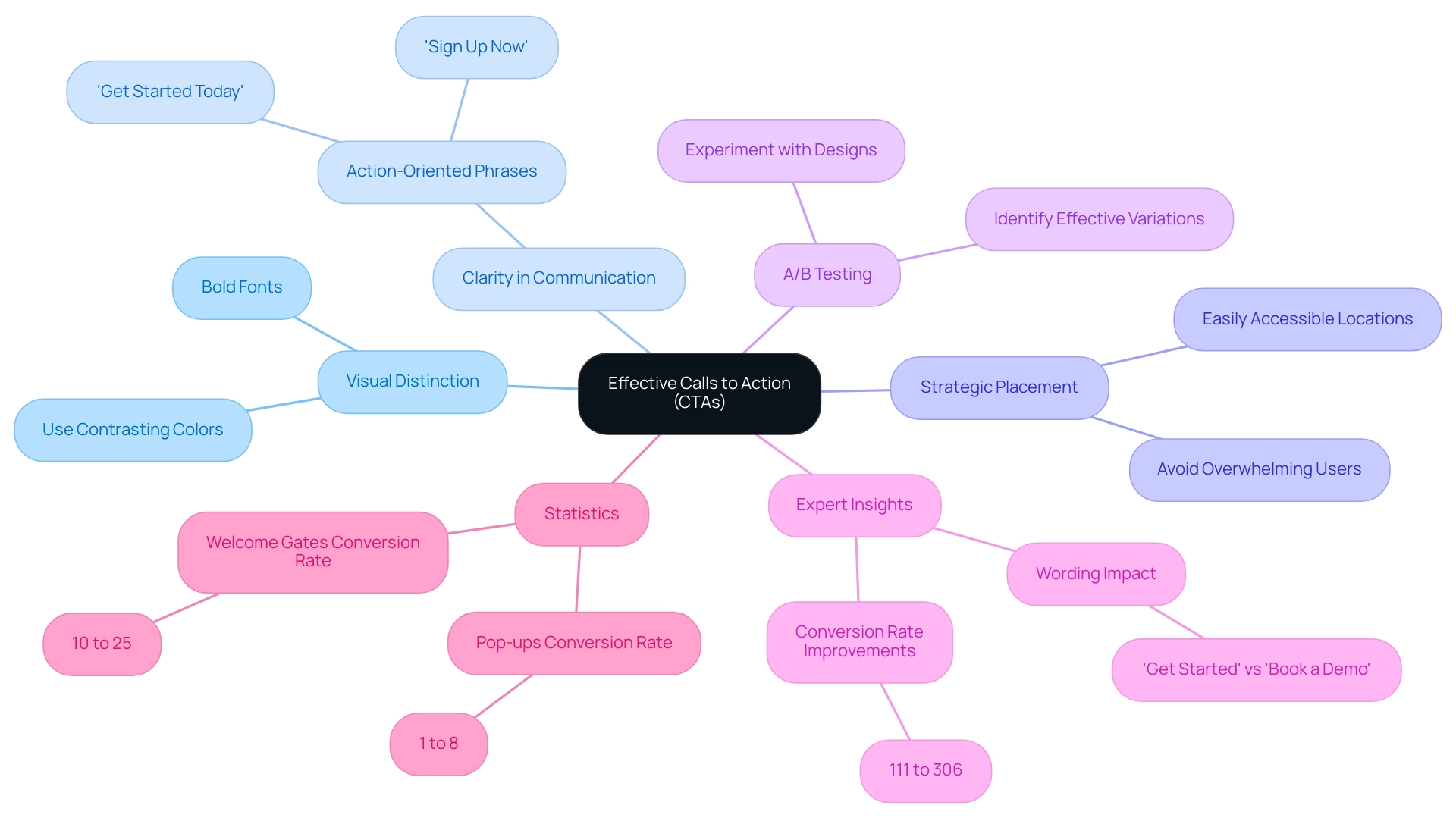
Maintain Consistent Branding Across Your Website
To establish an engaging online presence, it is essential to follow website design tips that ensure your site’s visual components—such as colors, fonts, and imagery—align with your overall identity. Creating a comprehensive style guide that incorporates these design tips is crucial; this document should outline visual elements to guarantee consistency across all pages of your site. Equally important is the consistent examination of your website to ensure that all content aligns with your voice and values.
Outdated elements must be updated promptly to keep your branding fresh and relevant.
WonderEight offers a variety of thorough branding and digital marketing solutions, including audits, gamification, and more, ensuring that your visual strategy is not only aesthetically pleasing but also strategically aligned with your business objectives. Statistics reveal that maintaining branding consistency can significantly impact consumer perception and loyalty. For instance, 27% of consumers view personalization as essential for fostering customer loyalty, emphasizing the necessity for a customized approach in your strategy.
Furthermore, research indicates that 62% of Gen Z shoppers prefer companies that prioritize sustainability, inclusion, and diversity, underscoring the importance of aligning your values with your design choices. This is particularly relevant as a recent case study shows that 62% of Gen Z shoppers are willing to pay more for brands that prioritize these values, emphasizing the need for brands to reflect their commitment to social responsibility.
Successful examples of branding consistency can be seen in various case studies. Brands that effectively implement style guides not only enhance their visual identity but also foster trust among consumers. For instance, a well-known tech company utilized a detailed style guide to ensure that all digital touchpoints reflected their commitment to innovation and user experience, resulting in increased customer engagement and loyalty.
Additionally, strong employer branding can increase employee retention by as much as 28%, potentially reducing new hire costs by 50%, illustrating the broader impact of branding beyond just consumer perception.
Expert insights indicate that a well-designed style guide, along with website design tips, acts as a roadmap for ensuring consistent branding across digital platforms. This guide should include specifications for logo usage, color palettes, typography, and imagery styles, ensuring that every aspect of your online presence resonates with your identity. By prioritizing these elements, you can create a unified and impactful platform that effectively conveys your message.
As noted in the quote, “Social Responsibility and Consumer Behavior,” aligning your brand values with your design choices is essential for building trust and loyalty among consumers.
To explore how WonderEight can elevate your branding efforts through our tailored services, contact us today and let’s discuss how we can help you achieve your business goals.
Optimize Your Website for Speed and Performance
Regularly testing your website’s speed is crucial for maintaining an optimal online presence. Utilize tools such as Google PageSpeed Insights or GTmetrix to assess your site’s performance. These platforms not only provide a score but also offer actionable recommendations for improvement.
For instance, optimizing images, minimizing HTTP requests, and leveraging browser caching can significantly enhance load times. Research shows that you can improve your page speed from a 30/100 score to a solid 90/100 or higher with a one-day implementation.
In 2025, implementing a content delivery network (CDN) is increasingly vital, as it allows for faster content delivery to individuals across various geographical locations, thereby enhancing the user experience. A leading e-commerce giant experienced a 16% decline in customer satisfaction due to a mere two-second delay in load time, underscoring the importance of speed in retaining users.
Moreover, the relationship between site speed and search engine optimization (SEO) cannot be overstated. According to the case study titled “The Relationship Between Speed and SEO,” quicker platforms tend to rank higher in search results, which translates to increased traffic and higher conversion rates. Regular monitoring of your site’s performance enables you to identify and address issues promptly, ensuring that your platform remains competitive in the evolving digital landscape.
Utilizing these website design tips not only enhances the user experience but also positions your brand favorably in search rankings, ultimately driving better business outcomes. Staying prepared for new challenges and opportunities in speed optimization is crucial as the digital landscape continues to evolve.
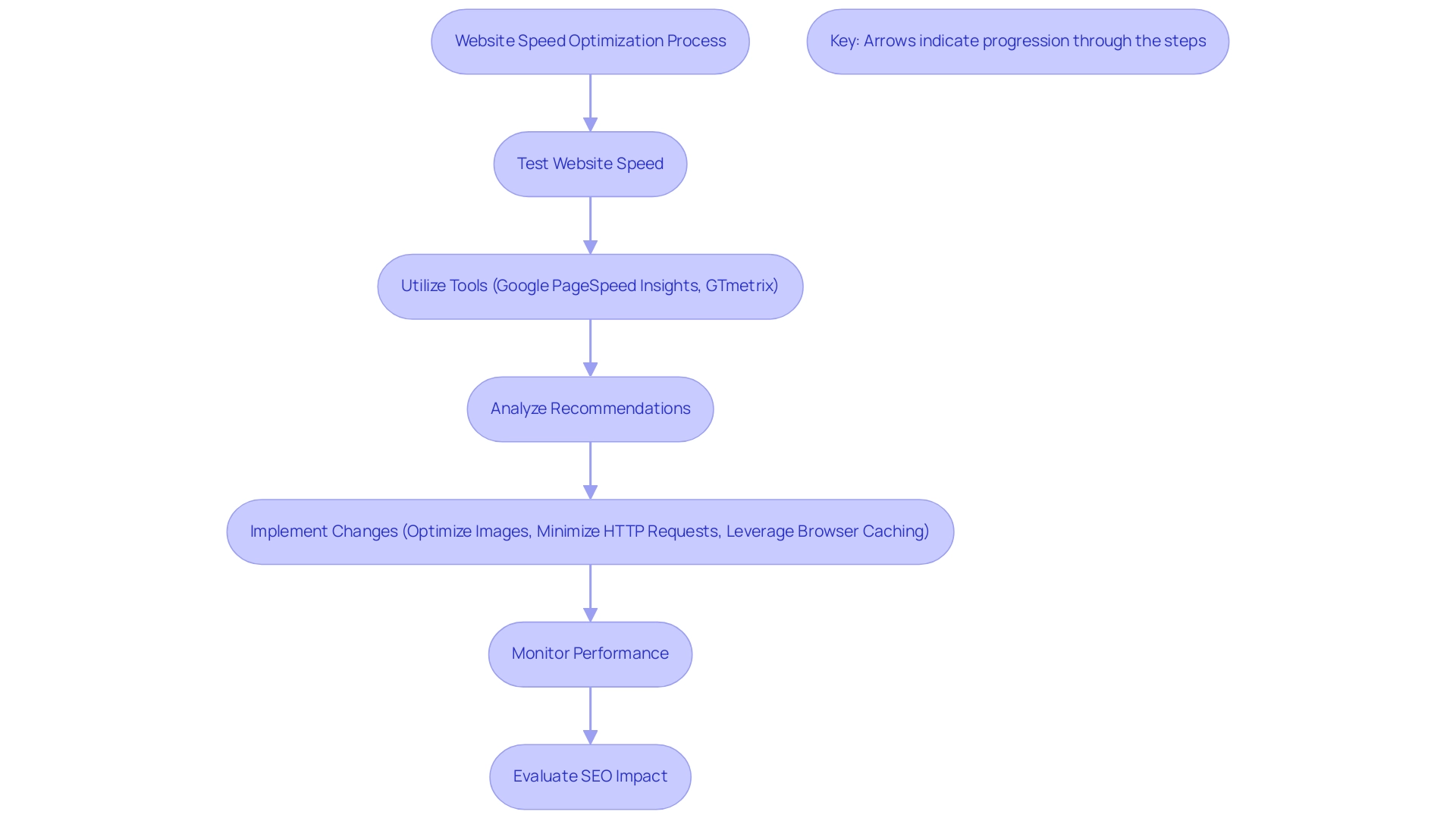
Regularly Test and Update Your Website
Establishing a routine for assessing your site’s functionality, grounded in website design tips, is essential for delivering a seamless experience for visitors. This involves thoroughly checking links, forms, and interactive elements to ensure their proper operation. Regular content updates are vital for keeping your website design tips fresh and relevant; statistics reveal that platforms with updated content enjoy significantly higher engagement rates.
Consider this: over 50% of consumers are unlikely to purchase from brands with poorly designed mobile sites. This statistic underscores the critical role of mobile optimization within your website design strategy. Alarmingly, 96% of users have encountered websites that lack mobile optimization, highlighting the widespread nature of this challenge.
To further elevate user experience, it is imperative to keep all software, plugins, and security measures up to date. Regular updates not only safeguard your site but also enhance its performance. Actively gathering audience feedback is another powerful strategy; it enables you to pinpoint areas for improvement directly from your users.
Moreover, leveraging analytics data can inform adjustments that boost user engagement. As Elizabeth Romanski, Consumer Marketing & Analytics Manager, aptly states, ‘You don’t need a development background to make VWO work for you.’ The VWO support team is exceptional in assisting with this process.
Best practices in website design suggest that sites should undergo testing at least once a month to maintain optimal functionality. This regularity can profoundly impact visitor experience, as 53% of mobile site users abandon pages that take longer than three seconds to load. Furthermore, the case study titled “Mobile UX Optimization” emphasizes that refining mobile UX is essential for businesses aiming to enhance user engagement and retention; a well-designed mobile site can lead to increased conversions and foster customer loyalty.
By prioritizing routine testing and updates, you can cultivate a more engaging and effective online presence that resonates profoundly with your audience.
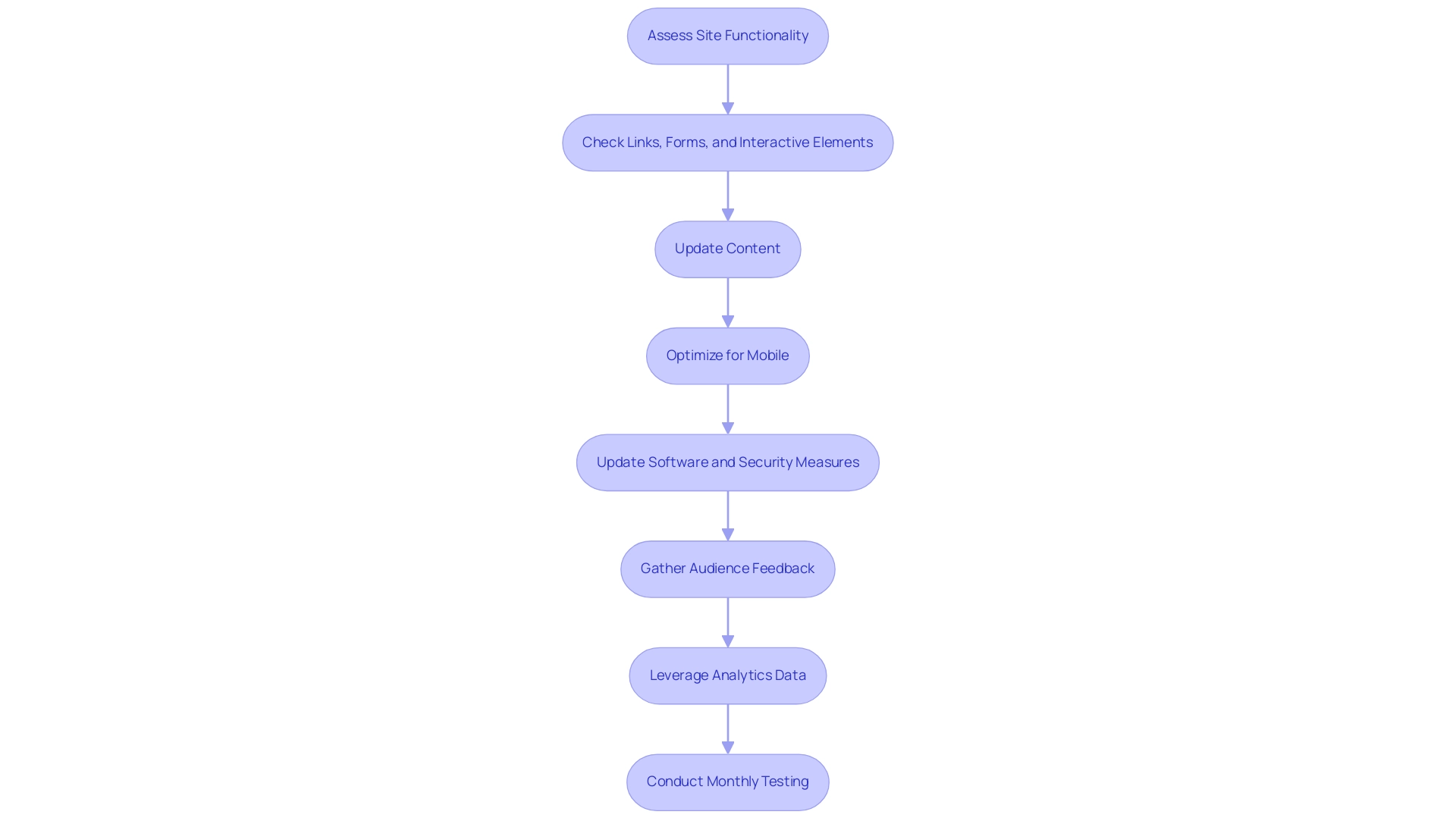
Conclusion
A well-crafted website stands as a fundamental asset for any business striving for success in the competitive digital landscape. By developing a comprehensive design plan that aligns with business goals and user needs, companies can establish a robust foundation for their online presence. Prioritizing user experience through intuitive navigation and regular feedback is essential to keep visitors engaged and satisfied.
Responsive design has become a necessity; with the surge in mobile traffic, websites must adapt seamlessly to various devices to maintain their effectiveness. Employing visual hierarchy and high-quality visuals not only enhances aesthetics but also directs users toward key information, ultimately driving conversions. Clear and concise website copy further complements these efforts, ensuring that the message resonates with the audience.
Effective calls to action are pivotal in fostering user engagement, while consistent branding across all pages cultivates trust and loyalty among consumers. Moreover, optimizing speed and performance is crucial, as website loading times can significantly influence user satisfaction and retention.
Regular testing and updates are vital for sustaining a seamless user experience and keeping content relevant. By implementing these strategies, businesses can forge an impactful online presence that not only captures attention but also drives meaningful engagement and conversions. Ultimately, investing in thoughtful web design is a strategic necessity that paves the way for lasting success in the digital arena.
Frequently Asked Questions
Why is establishing website goals important in the design process?
Establishing website goals is crucial as it ensures that your online presence aligns with business objectives and addresses the needs of your target audience.
What is the purpose of developing a sitemap for a website?
A sitemap outlines the structure of your site, highlighting main pages and subpages, which guides the creation process and enhances user navigation, while also improving SEO efforts.
How can wireframes assist in website design?
Wireframes help visualize the arrangement and flow of the online platform before actual creation, allowing for experimentation with layouts and functionalities to ensure a user-friendly and visually appealing outcome.
What role does user experience (UX) play in website design?
UX is essential as it involves understanding the needs and preferences of the target audience, which facilitates intuitive navigation and keeps visitors engaged.
How can feedback from clients improve website design?
Regularly collecting client feedback helps identify pain points and areas for improvement, enhancing the overall user experience and fostering a connection with the audience.
What are the current trends in mobile optimization for websites?
Mobile optimization is increasingly important, with statistics showing that a significant portion of web traffic originates from mobile devices, necessitating responsive design to enhance user experience.
What strategies can be used to create a responsive website design?
Utilizing flexible grid layouts and media queries, testing the site on various devices, and employing responsive web design techniques like fluid grids and flexible images are key strategies.
Why is it important to tailor online experiences for mobile users?
Tailoring experiences for mobile users can significantly boost engagement and conversion rates, as mobile users are more likely to purchase from companies that offer personalized product recommendations.
How can tools like Google’s Mobile-Friendly Test be beneficial?
Tools like Google’s Mobile-Friendly Test provide valuable insights into your site’s responsiveness, helping ensure that all elements display correctly and navigation remains intuitive.
What is the significance of incorporating transparency and measurable results in the website creation process?
Incorporating transparency and measurable results enhances the chances of establishing a remarkable online presence that resonates with the audience and drives business outcomes.



